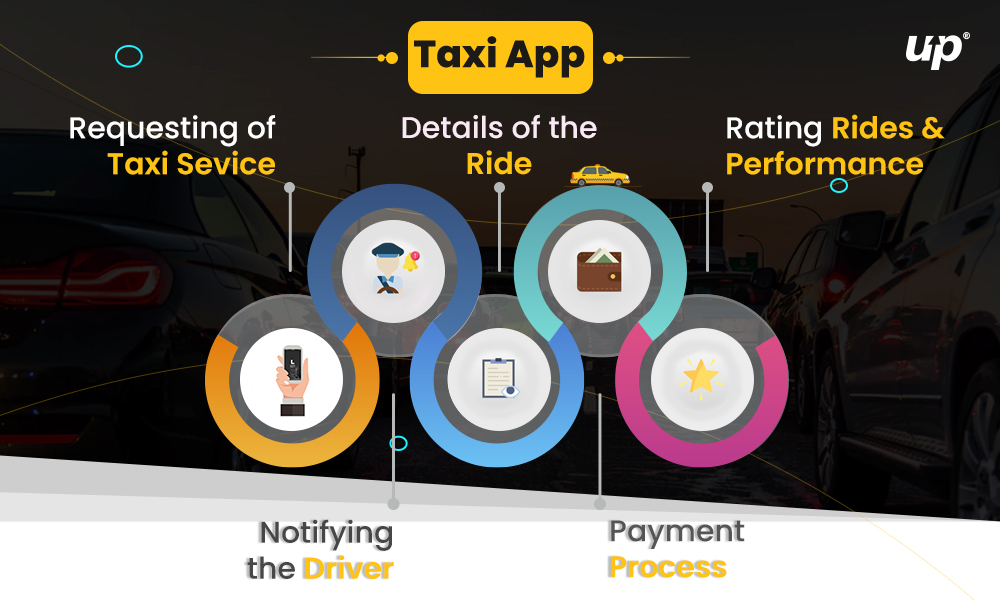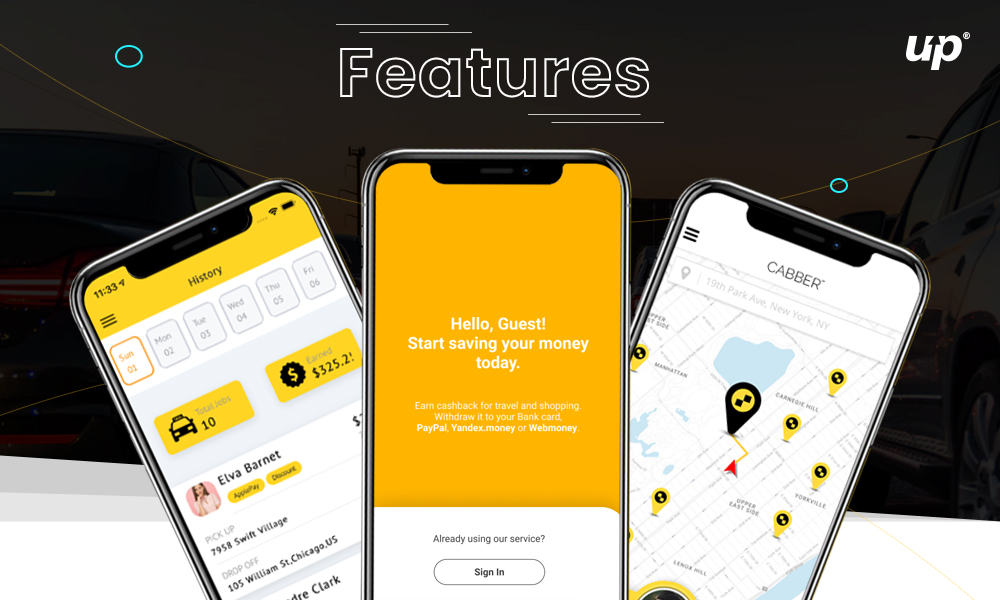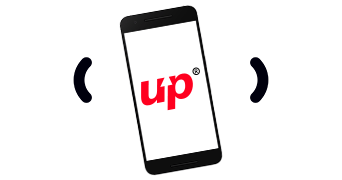Do you remember the struggles that we had to go through while booking a taxi? Back then, we only had two options, whether to call a taxi company or catch a cab by just screaming out its name on the road. Well, it’s 2019, and those days are long gone. Today, app development companies are breaking grounds in making on-demand applications, and the best part is Taxi booking apps are one of them.
With apps like Uber and Lyft, customers are now able to book cabs 24/7, see how much time will it be taking to reach the destination, and a cherry on top, you can pay them digitally. Additionally, the app is also proven to be helpful for drivers as they can accept or decline the request with just a single tap, call the customer if they don’t show up on the location, and even offer them different modes for payments.
Just a few months back, one of the best taxi booking apps, i.e Uber, registered its first-quarter revenue of more than $3.1 billion. It literally showed us that this is a perfect business venture on which start-ups and established business would like to invest in. As a matter of fact, over the last decade, we have seen increased popularity in automated taxi solutions.
We, being a taxi app development company, will be covering up all the necessary things that you’ll need while making a taxi app. If you’d like to dive deep into the technical aspects of app development, feel free to read this blog until the end, and hopefully you’ll be set free from all your possible doubts.
Also Read: Top 5 React-Native Courses for Mobile App Developers
The Welfare of Both the Sides
Now, most of you must be thinking “what does that even mean?” to be honest that’s a valid question as long as you are not aware of the technical aspect of taxi booking apps. But, don’t sweat it, as we are here to clear out all your doubts. Taxi apps are two-sided platforms, it is necessary to have a value proposition for both the sides, i.e customers and the drivers.

Propositions You Need To Focus On While Serving Up Customers:
![]() Call A Cab With Just A Single Tap 24/7
Call A Cab With Just A Single Tap 24/7
![]() Track The Assigned Driver
Track The Assigned Driver
![]() Estimated Cost And Duration Of The Ride
Estimated Cost And Duration Of The Ride
![]() Low Prices When Compared To Other Services
Low Prices When Compared To Other Services
![]() Fixed Rates For Places Like Airport
Fixed Rates For Places Like Airport
![]() Cashless Transactions
Cashless Transactions
![]() A Rating System To Know What Customers Think Of The Services
A Rating System To Know What Customers Think Of The Services
![]() Discounts And Free Rides On Certain Occasions
Discounts And Free Rides On Certain Occasions
The Value Proposition For The Drivers
![]() Insurance Coverage
Insurance Coverage
![]() Income Generation
Income Generation
![]() Easy Mobile Payment Procedure
Easy Mobile Payment Procedure
![]() No Upfront Investment In Joining
No Upfront Investment In Joining
![]() Flexible Work Hours
Flexible Work Hours
![]() Possibility To Earn More In Peak Periods
Possibility To Earn More In Peak Periods
![]() Get Customers In An Easier Way
Get Customers In An Easier Way
![]() The Possibility To Contact The Customer
The Possibility To Contact The Customer
It’s important for you to keep in mind that these value propositions are examples; you need to consider them general ones.
What’s the Benefit of Making a Taxi Booking App?
Ease of access is one of those things on which the world is totally focused on right now. And taxi-booking applications are just another step forward to make things even easier. If you are looking forward to making an app, then we’d recommend you to choose a reliable app development company that can help you out in the best possible way.
Before moving any further in your app development process, you must be aware of the fact that there are various taxi-hailing applications out there. Namely:
![]() Cab Management System (CMS)
Cab Management System (CMS)
![]() White Label Taxi (WLT)
White Label Taxi (WLT)
![]() Car on Demand (CoD)
Car on Demand (CoD)
![]() Custom Made Applications (CMA)
Custom Made Applications (CMA)
Revenue Model of Taxi Booking Application
Now is the time for us to take you guys to the insight into the revenue model of a taxi booking application. For a better understanding of this sophisticated aspect, we’ll be taking the example of the world’s most renowned company, Uber.
Various Cabs for Various Customers
With such applications, users have to ability to choose a cab as per their requirements. Uber, for instance, has not limited itself to a specific type of car; instead, the company has got separate segment vehicles for different customers.
In the United States, the company has got; Uber X, Uber Black – for those customers who prefer to travel in a black car, Uber Taxi – for those who look for a more economical solution of travelling and Uber SUV – for those luxury matters the most. They are providing their customers with the option to choose the car they would like to travel in, which gives them an ultimate taxi booking experience.
Pricing Strategy at its best
This is probably the most powerful aspect of Uber. It is a known fact that Uber’s compelling pricing strategy is quite unique in the market which has also got its competitors in a state of havoc since all of them are trying to outsmart each other.
Usually, taxi companies increase fares whenever there is more demand than supply. Uber, on the other hand, charges its customers based on the traffic density and the time taken to arrive from point A to B.
There’s one more thing that you need to know is that price per mile automatically changes depending on the number of available driver and the number of requests made by the people who are searching for a ride.
Alternative Rides
Quite recently Uber announced that it would be offering boats, helicopters, and other additional transportation options. Other than that, the company just launched a motorcycle-pickup service in Paris, a delivery service in San Francisco, and an ice-cream-truck-delivery service in a few cities. Now you should know for the fact that all these services are limited to just a handful of cities, yet have resulted in a revenue boom to its business model.
Functionalities at a Glance
Now that we are done with discussing value proposition and revenue model of a taxi booking app, it’s time for us to dive deep into the functionalities that you as a mobile app developer need to consider while making such an app. Now, for your own convenience, we’ve enlisted some of the basic functionalities you need to provide your users.
Signup: This is literally the most basic facility you need to provide your users with. You can also give options to login with Facebook, Google Plus or just the regular way. Choosing login through social media can transfer personal data into the app in just a few seconds.
Personal Profile: Users and even drivers can add, delete, or edit their personal information at any time through the app.

Car Searching feature: To provide the customer with a taxi as quickly as possible, Uber integrated the car searching by minimum kilometer option. This lets the customer filter only the closest taxis to the desired location.
Fare Estimation: Since paid fares directly affect the revenue model, it’s important to include a fare estimation mechanism. With its incorporation, the app will be able to calculate the travel fare based on the standard prices for a particular distance.
Availability of Cars: You’ll only be able to book that taxi whose status is active, once the taxi is booked, its status will automatically become inactive so that the driver doesn’t have to do it manually.
Maps: Google Maps can really help a lot when it comes down to navigation, calculating the distance between point A and B, and even the fare estimation.
Multiple Payment Options: It means the option that lets a customer pay cashless with a debit or credit card. Another option is to transfer money to the app wallet for further consumption.
Email Templates: Notification emails are useful to send out payment details, transactions confirmations, wallet information, travel details, or to fix a forgotten password.
Additional Functionalities
The ones that we mentioned above are primary functionalities which means you need to provide them to your users. Now, the ones that we are about to mention; will make your app more complex and user-friendly at the same time.
Car Categories: With this feature, the customer will be able to choose the type of car which he’d like to travel towards the destination. By providing such a feature, you can reach out to different target groups (economic sections) at once.
History Details: Incorporating this feature can help your customers see the details of their past rides like the date, pick up and drop off location, total amount paid, and along with car details.
Multi-language: If you are planning on launching your application in different countries, then we’d recommend you to provide the app with different regional languages for better accessibility.
Promo Codes: Every time a new user register with a promo code, gets the first ride for free.
Convenience was one of the major reasons why taxi booking apps were introduced. In today’s world, every single one of us prefers ease in almost every single task and making a taxi app is just another breakthrough.
Final Thoughts
Are you planning on making an app for your business? If yes! Then we are glad to tell you that this is the right place you are looking at. Being a top-rated mobile app development company in USA, Fluper and its developers would be very happy to help you out. Feel free to contact us for any app development query, and we’ll do our best to provide you with a solution as soon as possible.











